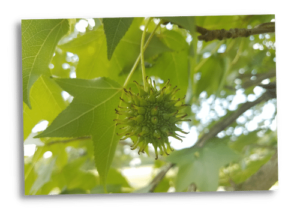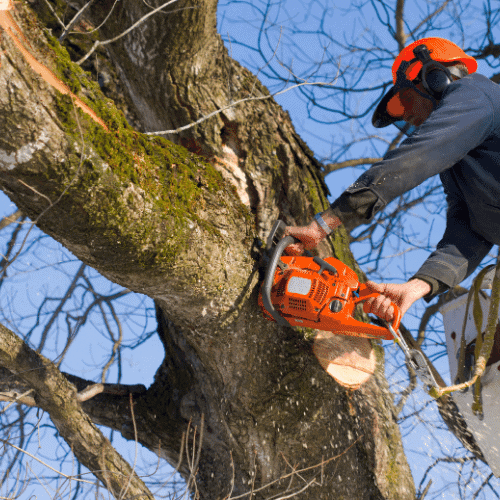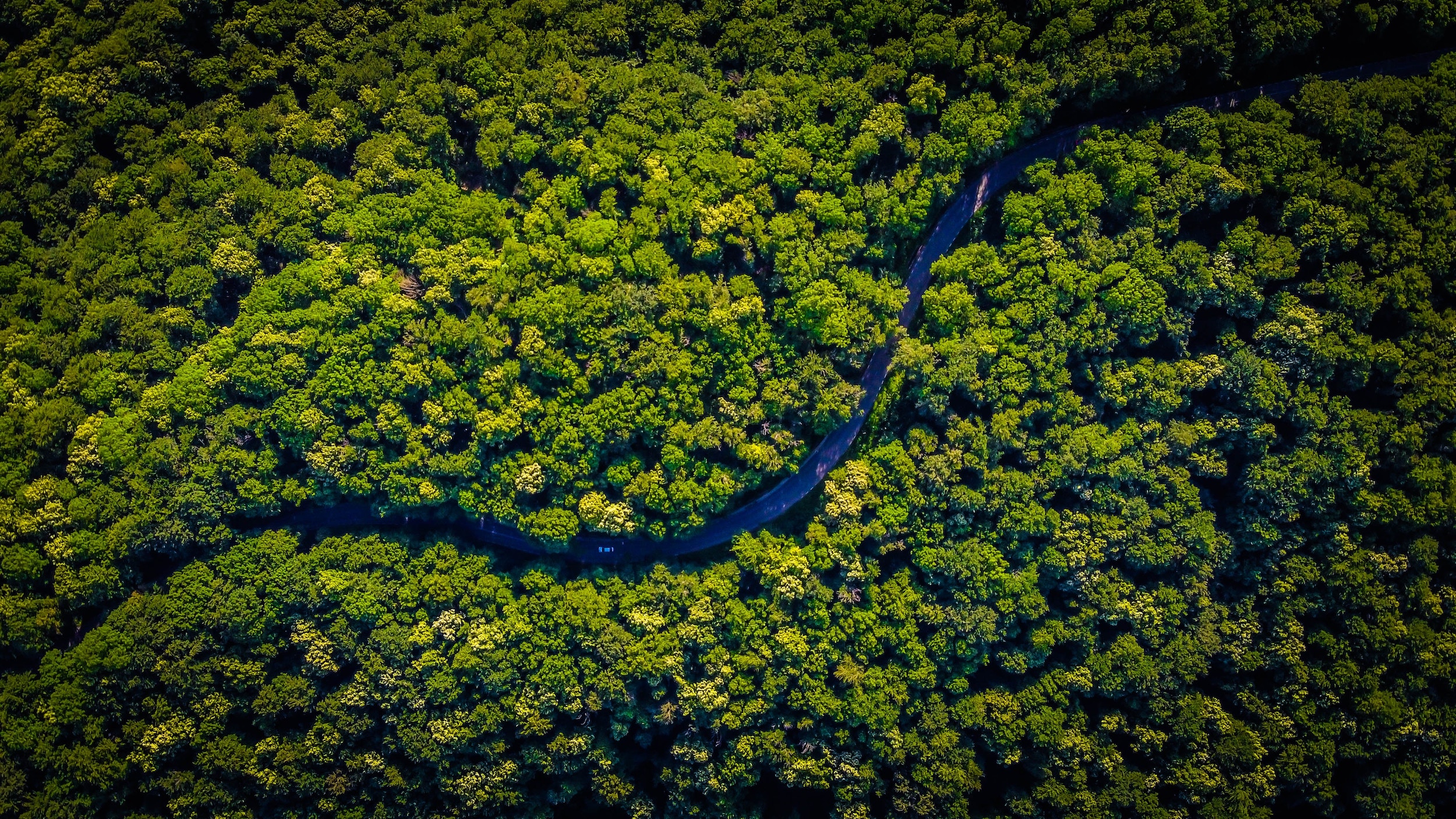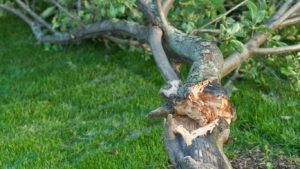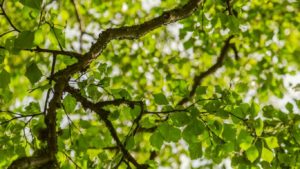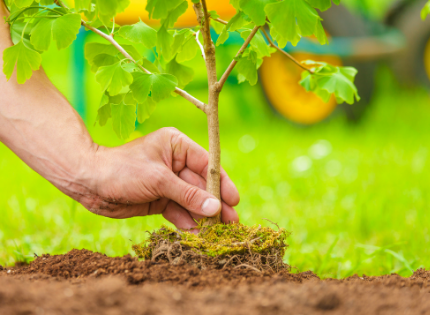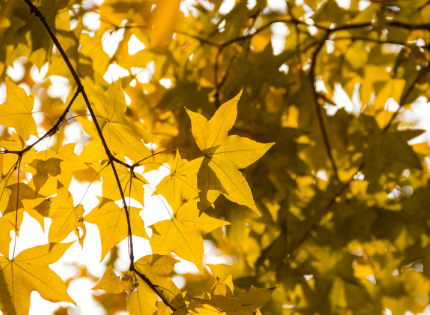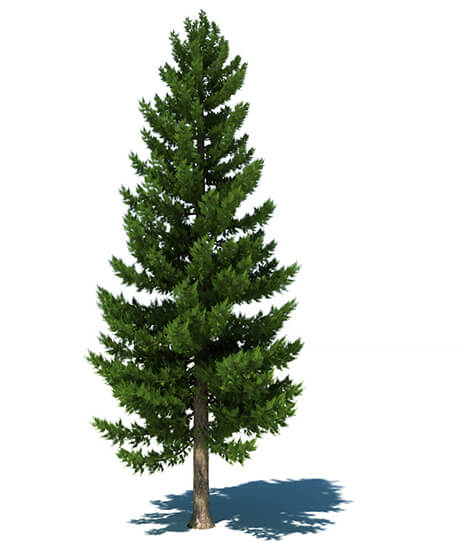How to Identify an Elm
- LEAVES: The first place to begin in identifying any tree is to look at its leaves.American elm leaves are oval in shape with an asymmetrical base and a point at the leaf apex. The edges of the leaves are serrated and the body of the leaves have visible veins. American elm leaves are typically 4-6 inches in length. Elms are deciduous and semi-deciduous, meaning they lose their leaves in the fall and remain bare until spring when regrowth begins.
- BARK: Elm bark is known to be very coarse and appears in interlocking diagonal shapes.The bark coloring is gray to brown. However, species of elm vary in their bark coloring and texture.
- SHAPE AND GROWTH: Elms grow in a vase-like shape.While various species of elms grow to different heights, American elms typically grow to a height of around 115-128 feet with their trunks reaching a diameter of about 5-6 feet. Including all of their branches and leaves, they can grow to be 121 feet wide.
- TRUNK AND ROOTS: The trunks of elm trees typically branch into two or more main trunks that make up the top half of the tree. Visible roots sometimes referred to as “feet” jut out at the bottom of elms.
 BUDS: Some species of elm sprout little buds that range from purple to red in color.
BUDS: Some species of elm sprout little buds that range from purple to red in color. SEEDS: An elm’s seeds drop from the tree in late spring to early summer. They are pea-sized, round, flat, and protected by a thin green casing.
SEEDS: An elm’s seeds drop from the tree in late spring to early summer. They are pea-sized, round, flat, and protected by a thin green casing.
Various Elm Species
 AMERICAN ELM: This species is also known as water elm, soft elm, white elm, gray elm, and Florida elm. These are found all across the United States, but are more common on the eastern half of the country.
AMERICAN ELM: This species is also known as water elm, soft elm, white elm, gray elm, and Florida elm. These are found all across the United States, but are more common on the eastern half of the country. CAMPERDOWN ELM: This species of elm has a beautiful weeping shape and can grow to be around 30 feet tall. It is found primarily in the United Kingdom and is also known as weeping elm or umbrella elm.
CAMPERDOWN ELM: This species of elm has a beautiful weeping shape and can grow to be around 30 feet tall. It is found primarily in the United Kingdom and is also known as weeping elm or umbrella elm. SLIPPERY ELM: Occasionally referred to as soft elm, the slippery elm gets its name from a viscous liquid secreted by its bark. It is native to eastern regions of North America.
SLIPPERY ELM: Occasionally referred to as soft elm, the slippery elm gets its name from a viscous liquid secreted by its bark. It is native to eastern regions of North America.
 ENGLISH ELM: English elms are found mostly in the western half of Europe including in countries like France, Spain, and the United Kingdom. They were much more common around England before Dutch elm disease wiped many out. English elms are one of the larger elm varieties and can grow to around 130 feet and taller.
ENGLISH ELM: English elms are found mostly in the western half of Europe including in countries like France, Spain, and the United Kingdom. They were much more common around England before Dutch elm disease wiped many out. English elms are one of the larger elm varieties and can grow to around 130 feet and taller. CEDAR ELM: Cedar elm is native to the southern part of North America. It stands up well to pollution and therefore is a great choice for urban environments. Other names for the cedar elm include basket elm, Texas cedar elm, and southern rock elm.
CEDAR ELM: Cedar elm is native to the southern part of North America. It stands up well to pollution and therefore is a great choice for urban environments. Other names for the cedar elm include basket elm, Texas cedar elm, and southern rock elm. SIBERIAN ELM: As the name suggests, Siberian elms are located in Siberia as well as other parts of Asia including Korea, India, Mongolia, parts of China, and the United States. It can thrive in even the harshest conditions and grow to be 70 feet tall.
SIBERIAN ELM: As the name suggests, Siberian elms are located in Siberia as well as other parts of Asia including Korea, India, Mongolia, parts of China, and the United States. It can thrive in even the harshest conditions and grow to be 70 feet tall.
 EUROPEAN ELM: The European elm species is common across the eastern half of Europe. It stands up well to heavy moisture and can grow to be 100 feet tall.
EUROPEAN ELM: The European elm species is common across the eastern half of Europe. It stands up well to heavy moisture and can grow to be 100 feet tall. CHINESE ELM: These grow to around 30-50 feet tall and can be found across China, Japan, and the United States. Chinese elms can withstand heavy pruning.
CHINESE ELM: These grow to around 30-50 feet tall and can be found across China, Japan, and the United States. Chinese elms can withstand heavy pruning. WINGED ELM: Winged elm trees are found in southern regions of the United States and they thrive in both wet and dry conditions. The name comes from the long wing-like growths that appear on the branches of this type of elm tree.
WINGED ELM: Winged elm trees are found in southern regions of the United States and they thrive in both wet and dry conditions. The name comes from the long wing-like growths that appear on the branches of this type of elm tree.
 DAVID ELM: This species of elm, sometimes called Japanese elm or Wilson’s elm, is found all across Asia. It stands up well against Dutch elm disease compared to other elm species.
DAVID ELM: This species of elm, sometimes called Japanese elm or Wilson’s elm, is found all across Asia. It stands up well against Dutch elm disease compared to other elm species. ROCK ELM: Primarily found in the U.S. midwest, rock elms are narrower than most elm species. It is also known as cork elm.
ROCK ELM: Primarily found in the U.S. midwest, rock elms are narrower than most elm species. It is also known as cork elm.
Creatures Found in and Around Elms
A wide range of creatures can be found in elm trees feed on their flowering buds, including:
- Caterpillars
- Raccoons
- Squirrels
- Woodpeckers
- Deer
- Rabbits
- Mice
- Opossums
- Birds
- Insects
Dutch Elm Disease
A serious issue for the survival of many elm trees is Dutch elm disease (DED). DED is a fungal disease that infects the water-directing channels of the elm tree and can kill them. The disease has already wiped out large swaths of them across the United States and around the world. For anyone with elm trees, DED is a major concern that you will want to take steps to mitigate.
CAUSES
It is caused by two main fungi: Ophiostoma ulmi and Ophiostoma novo-ulmi. The disease is transmitted through elm bark beetles and intersecting roots that fuse together. Infections can take anywhere from one season to two years to make their way through an entire elm tree.

 ELM BARK BEETLESThese beetles are drawn to struggling elms. Elm bark beetles dig under the bark of dying elm trees, lay their eggs, and then their larvae feed on the elm’s wood. If that tree happened to be infested by DED, then the fungus that has now either been ingested by the new beetles or has attached itself to them. When the beetles then travel to a healthy tree, they carry the disease with them and begin the process all over again.
ELM BARK BEETLESThese beetles are drawn to struggling elms. Elm bark beetles dig under the bark of dying elm trees, lay their eggs, and then their larvae feed on the elm’s wood. If that tree happened to be infested by DED, then the fungus that has now either been ingested by the new beetles or has attached itself to them. When the beetles then travel to a healthy tree, they carry the disease with them and begin the process all over again. GRAFTED ROOTSWhen trees of related species are growing in close proximity, roots can grow into each other and intersect. Eventually, what can happen is these roots can fuse together. This is a common way for an infected tree to pass DED onto a healthy tree and why oftentimes, a line of healthy trees can get wiped out quite quickly.
GRAFTED ROOTSWhen trees of related species are growing in close proximity, roots can grow into each other and intersect. Eventually, what can happen is these roots can fuse together. This is a common way for an infected tree to pass DED onto a healthy tree and why oftentimes, a line of healthy trees can get wiped out quite quickly.
Identifying Dutch Elm Disease
If you are able to identify DED early on, you may be able to save your elm tree. Here are some things to look out for that could indicate that your elm is infected by the disease:
 Branches of leaves are starting to yellow and brown prematurely.
Branches of leaves are starting to yellow and brown prematurely. The yellowing and browning starts to work its way down the affected branches toward the trunk.
The yellowing and browning starts to work its way down the affected branches toward the trunk. If the infection begins in the lower crown, the disease can move much quicker and the tree may be unsaveable.
If the infection begins in the lower crown, the disease can move much quicker and the tree may be unsaveable. Infected branches and shoots develop dark streaks along their outer rings.
Infected branches and shoots develop dark streaks along their outer rings. New shoots start to wilt early.
New shoots start to wilt early.
Preventing and Managing Dutch Elm Disease:
![]() Remove infected branches or entire trees as soon as possible in hopes of cutting out the infection before it spreads. Staying diligent in this effort is sometimes referred to as sanitation.Debark and destroy any wood from the affected elm tree through burning, chipping, or burying. Do not reuse the wood.
Remove infected branches or entire trees as soon as possible in hopes of cutting out the infection before it spreads. Staying diligent in this effort is sometimes referred to as sanitation.Debark and destroy any wood from the affected elm tree through burning, chipping, or burying. Do not reuse the wood.![]() Spray insecticide on non-infected elms near the end of summer to early fall.Disrupt root grafts between any connected elm trees, whether they are healthy or not. This is a great preventative measure to halt the spread of DED before it infects an area. You can cut a root graft through the use of a plow or trenching machine.
Spray insecticide on non-infected elms near the end of summer to early fall.Disrupt root grafts between any connected elm trees, whether they are healthy or not. This is a great preventative measure to halt the spread of DED before it infects an area. You can cut a root graft through the use of a plow or trenching machine.![]() If you are removing a tree affected by DED, it is important to break any root grafts before removing the tree to avoid unwanted transfers between roots.Some fungicides can be injected into elms to protect them from beetle transmission of DED. However, there are certain issues with this method such as the dosage needs to be absolutely perfect to be effective, it can lead to leaf scorching, and it can begin a decaying of the elm tree. The process also needs to be repeated every few seasons.
If you are removing a tree affected by DED, it is important to break any root grafts before removing the tree to avoid unwanted transfers between roots.Some fungicides can be injected into elms to protect them from beetle transmission of DED. However, there are certain issues with this method such as the dosage needs to be absolutely perfect to be effective, it can lead to leaf scorching, and it can begin a decaying of the elm tree. The process also needs to be repeated every few seasons.![]() There are now DED-resistant strains of elm trees for planting. Use those for any new plantings to stop the spread of the disease to new trees.
There are now DED-resistant strains of elm trees for planting. Use those for any new plantings to stop the spread of the disease to new trees.
Other Dangers to Elm Trees
Other problems that affect elm trees include elm leaf beetles (which are different from the DED-carrying elm bark beetles), leaf spot disease, elm yellows, and bacterial leaf scorch. Below are some signs of each.
- ELM LEAF BEETLESHoles in elm leaves

- LEAF SPOT DISEASEDark spots on the leaves

- ELM YELLOWSEntire crown of leaves begins to yellow and fall Slight darkening of inner bark Interior bark emits a wintergreen scent

- BACTERIAL SCORCHLeaf damage appears as browning with a yellow border Older leaves start to wither away before damage spreads branch by branch

Uses for Elm Wood
Elm is known as a durable, split-resistant wood that has a beautiful grain, which makes it a valued wood choice for the following items:
- Sturdy furniture: tables, chairs, stools, television stands
- Paneling
- Flooring
- Shelving
- Hockey Sticks
- Burl Veneer
- Crates
- Boxes
- Tools
- Musical Instruments

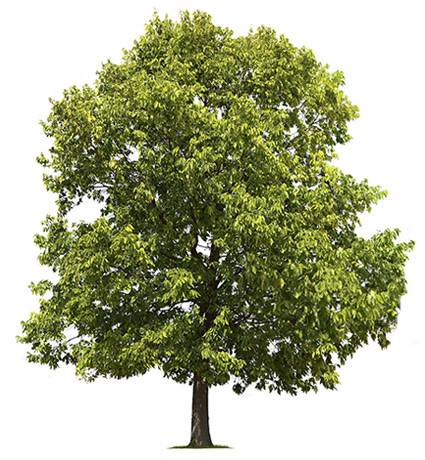
 BUDS: Some species of elm sprout little
BUDS: Some species of elm sprout little  SEEDS: An elm’s seeds drop from the tree in late spring to early summer. They are pea-sized, round, flat, and protected by a thin green casing.
SEEDS: An elm’s seeds drop from the tree in late spring to early summer. They are pea-sized, round, flat, and protected by a thin green casing. AMERICAN ELM: This species is also known as water elm, soft elm, white elm, gray elm, and Florida elm. These are found all across the United States, but are more common on the eastern half of the country.
AMERICAN ELM: This species is also known as water elm, soft elm, white elm, gray elm, and Florida elm. These are found all across the United States, but are more common on the eastern half of the country. CAMPERDOWN ELM: This species of elm has a beautiful weeping shape and can grow to be around 30 feet tall. It is found primarily in the United Kingdom and is also known as weeping elm or umbrella elm.
CAMPERDOWN ELM: This species of elm has a beautiful weeping shape and can grow to be around 30 feet tall. It is found primarily in the United Kingdom and is also known as weeping elm or umbrella elm. SLIPPERY ELM: Occasionally referred to as soft elm, the slippery elm gets its name from a viscous liquid secreted by its bark. It is native to eastern regions of North America.
SLIPPERY ELM: Occasionally referred to as soft elm, the slippery elm gets its name from a viscous liquid secreted by its bark. It is native to eastern regions of North America. ENGLISH ELM: English elms are found mostly in the western half of Europe including in countries like France, Spain, and the United Kingdom. They were much more common around England before Dutch elm disease wiped many out. English elms are one of the larger elm varieties and can grow to around 130 feet and taller.
ENGLISH ELM: English elms are found mostly in the western half of Europe including in countries like France, Spain, and the United Kingdom. They were much more common around England before Dutch elm disease wiped many out. English elms are one of the larger elm varieties and can grow to around 130 feet and taller. CEDAR ELM: Cedar elm is native to the southern part of North America. It stands up well to pollution and therefore is a great choice for urban environments. Other names for the cedar elm include basket elm, Texas cedar elm, and southern rock elm.
CEDAR ELM: Cedar elm is native to the southern part of North America. It stands up well to pollution and therefore is a great choice for urban environments. Other names for the cedar elm include basket elm, Texas cedar elm, and southern rock elm. SIBERIAN ELM: As the name suggests, Siberian elms are located in Siberia as well as other parts of Asia including Korea, India, Mongolia, parts of China, and the United States. It can thrive in even the harshest conditions and grow to be 70 feet tall.
SIBERIAN ELM: As the name suggests, Siberian elms are located in Siberia as well as other parts of Asia including Korea, India, Mongolia, parts of China, and the United States. It can thrive in even the harshest conditions and grow to be 70 feet tall. EUROPEAN ELM: The European elm species is common across the eastern half of Europe. It stands up well to heavy moisture and can grow to be 100 feet tall.
EUROPEAN ELM: The European elm species is common across the eastern half of Europe. It stands up well to heavy moisture and can grow to be 100 feet tall. CHINESE ELM: These grow to around 30-50 feet tall and can be found across China, Japan, and the United States. Chinese elms can withstand heavy pruning.
CHINESE ELM: These grow to around 30-50 feet tall and can be found across China, Japan, and the United States. Chinese elms can withstand heavy pruning. WINGED ELM: Winged elm trees are found in southern regions of the United States and they thrive in both wet and dry conditions. The name comes from the long wing-like growths that appear on the branches of this type of elm tree.
WINGED ELM: Winged elm trees are found in southern regions of the United States and they thrive in both wet and dry conditions. The name comes from the long wing-like growths that appear on the branches of this type of elm tree. DAVID ELM: This species of elm, sometimes called Japanese elm or Wilson’s elm, is found all across Asia. It stands up well against Dutch elm disease compared to other elm species.
DAVID ELM: This species of elm, sometimes called Japanese elm or Wilson’s elm, is found all across Asia. It stands up well against Dutch elm disease compared to other elm species. ROCK ELM: Primarily found in the U.S. midwest, rock elms are narrower than most elm species. It is also known as cork elm.
ROCK ELM: Primarily found in the U.S. midwest, rock elms are narrower than most elm species. It is also known as cork elm. ELM BARK BEETLESThese beetles are drawn to struggling elms. Elm bark beetles dig under the bark of dying elm trees, lay their eggs, and then their larvae feed on the elm’s wood. If that tree happened to be infested by DED, then the fungus that has now either been ingested by the new beetles or has attached itself to them. When the beetles then travel to a healthy tree, they carry the disease with them and begin the process all over again.
ELM BARK BEETLESThese beetles are drawn to struggling elms. Elm bark beetles dig under the bark of dying elm trees, lay their eggs, and then their larvae feed on the elm’s wood. If that tree happened to be infested by DED, then the fungus that has now either been ingested by the new beetles or has attached itself to them. When the beetles then travel to a healthy tree, they carry the disease with them and begin the process all over again. GRAFTED ROOTSWhen trees of related species are growing in close proximity, roots can grow into each other and intersect. Eventually, what can happen is these roots can fuse together. This is a common way for an infected tree to pass DED onto a healthy tree and why oftentimes, a line of healthy trees can get wiped out quite quickly.
GRAFTED ROOTSWhen trees of related species are growing in close proximity, roots can grow into each other and intersect. Eventually, what can happen is these roots can fuse together. This is a common way for an infected tree to pass DED onto a healthy tree and why oftentimes, a line of healthy trees can get wiped out quite quickly.